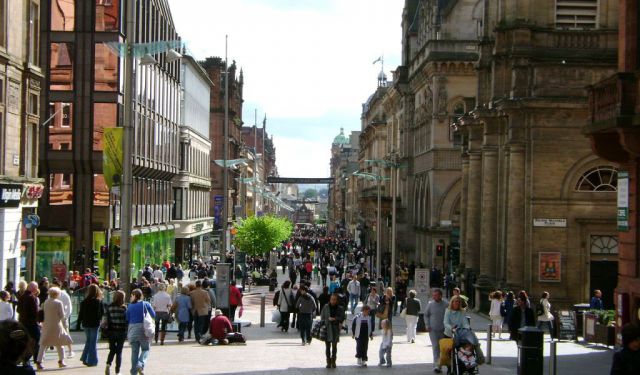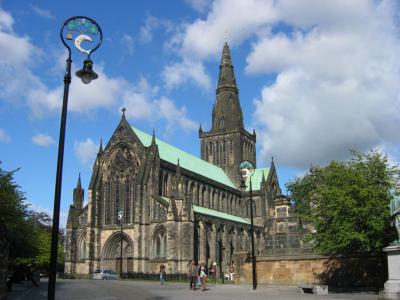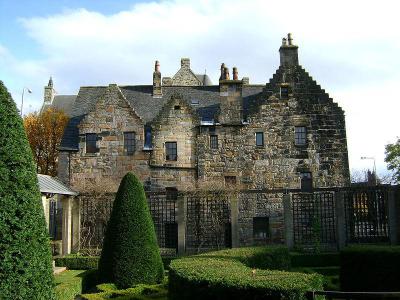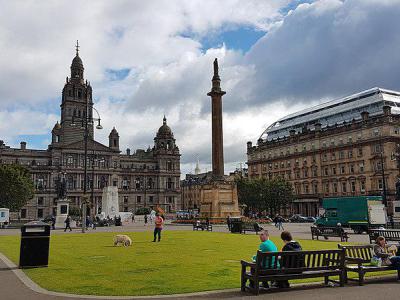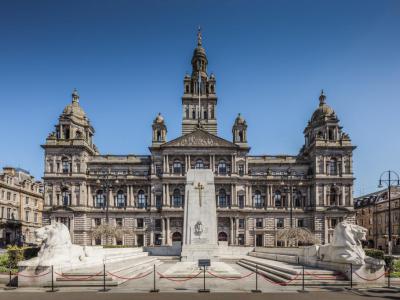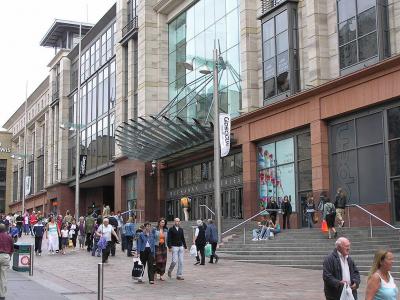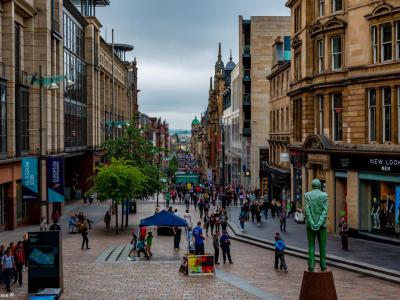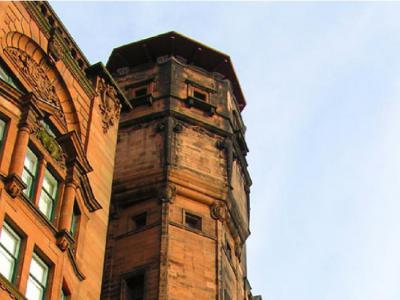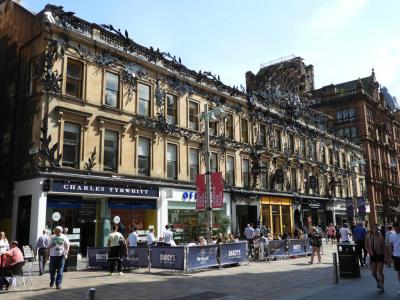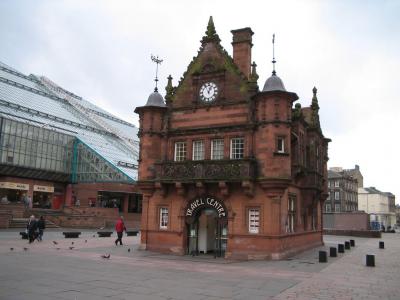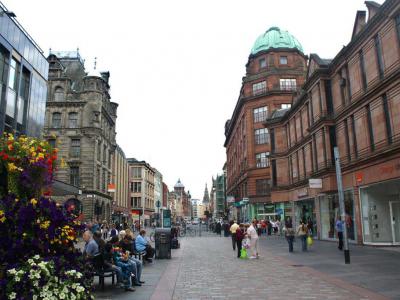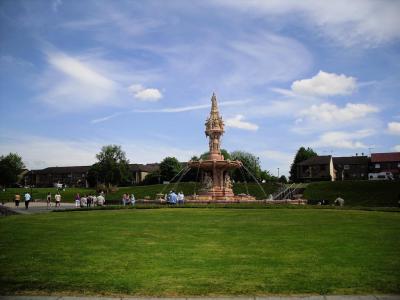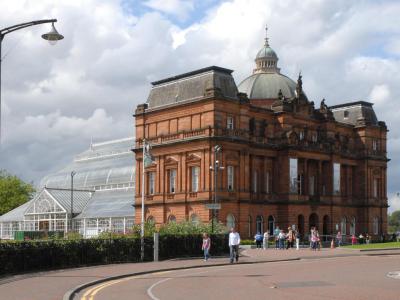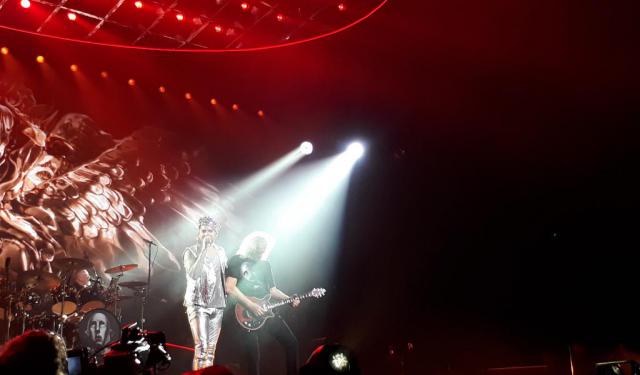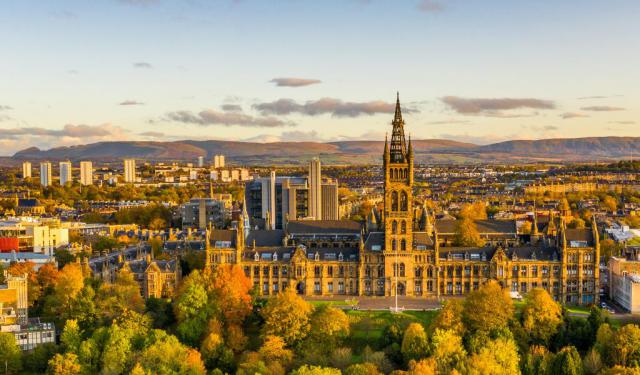Glasgow Introduction Walking Tour (Self Guided), Glasgow
The largest city and seaport in Scotland, Glasgow is also one of the country's most popular tourist destinations. Famed for its 19th-century Victorian and Art Nouveau architecture, numerous musical events, football matches, traditional pubs, and food venues, this place is truly unique.
The area of Glasgow in Scotland's western Lowlands has been inhabited for millennia, with the River Clyde providing a natural location for fishing. Glasgow itself grew from a small rural settlement on the river, reputedly founded by the Christian missionary Saint Mungo in the 6th century. He established a church on the Molendinar Burn, where the present Glasgow (aka St Mungo's) Cathedral stands.
The name Glasgow is of Brittonic origin and means "green-hollow", which may refer to the ravine east of the Cathedral.
In addition to being a religious center, the establishment of the University of Glasgow in 1451 paved way to the city's becoming a major center of the Scottish Enlightenment in the 18th century. Thenceforth, Glasgow also grew as one of Great Britain's main hubs of transatlantic trade with North America and the West Indies. With the onset of the Industrial Revolution, the population and economy of the city expanded rapidly, making it one of the world's pre-eminent centers of shipbuilding and marine engineering.
Daniel Defoe, visiting Glasgow in the early 18th century, famously described it as "the cleanest and beautifullest, and best built city in Britain, London excepted". For much of the Victorian and Edwardian eras it remained the "Second City of the British Empire".
The rich legacy of the 18th–20th century prosperity helped the city's evolution into a national cultural hub, home to such institutions as the Scottish Opera, Scottish Ballet and National Theatre of Scotland, as well as acclaimed museums and a thriving music scene.
The heart of the city is George Square, site of many of public statues and the elaborate Victorian Glasgow City Chambers. To the south and west are the shopping precincts of Argyle Street and Buchanan Street. The latter is a home to Buchanan Galleries, a major retail venue similar in grandness to that of St. Enoch Centre (linking Argyle Street and St Enoch Square), with the up-market Princes Square not far away.
If you wish to make a closer acquaintance with these and other popular sights of Glasgow, don't miss a chance to do that with the help of our self-guided walking tour!
The area of Glasgow in Scotland's western Lowlands has been inhabited for millennia, with the River Clyde providing a natural location for fishing. Glasgow itself grew from a small rural settlement on the river, reputedly founded by the Christian missionary Saint Mungo in the 6th century. He established a church on the Molendinar Burn, where the present Glasgow (aka St Mungo's) Cathedral stands.
The name Glasgow is of Brittonic origin and means "green-hollow", which may refer to the ravine east of the Cathedral.
In addition to being a religious center, the establishment of the University of Glasgow in 1451 paved way to the city's becoming a major center of the Scottish Enlightenment in the 18th century. Thenceforth, Glasgow also grew as one of Great Britain's main hubs of transatlantic trade with North America and the West Indies. With the onset of the Industrial Revolution, the population and economy of the city expanded rapidly, making it one of the world's pre-eminent centers of shipbuilding and marine engineering.
Daniel Defoe, visiting Glasgow in the early 18th century, famously described it as "the cleanest and beautifullest, and best built city in Britain, London excepted". For much of the Victorian and Edwardian eras it remained the "Second City of the British Empire".
The rich legacy of the 18th–20th century prosperity helped the city's evolution into a national cultural hub, home to such institutions as the Scottish Opera, Scottish Ballet and National Theatre of Scotland, as well as acclaimed museums and a thriving music scene.
The heart of the city is George Square, site of many of public statues and the elaborate Victorian Glasgow City Chambers. To the south and west are the shopping precincts of Argyle Street and Buchanan Street. The latter is a home to Buchanan Galleries, a major retail venue similar in grandness to that of St. Enoch Centre (linking Argyle Street and St Enoch Square), with the up-market Princes Square not far away.
If you wish to make a closer acquaintance with these and other popular sights of Glasgow, don't miss a chance to do that with the help of our self-guided walking tour!
How it works: Download the app "GPSmyCity: Walks in 1K+ Cities" from Apple App Store or Google Play Store to your mobile phone or tablet. The app turns your mobile device into a personal tour guide and its built-in GPS navigation functions guide you from one tour stop to next. The app works offline, so no data plan is needed when traveling abroad.
Glasgow Introduction Walking Tour Map
Guide Name: Glasgow Introduction Walking Tour
Guide Location: Scotland » Glasgow (See other walking tours in Glasgow)
Guide Type: Self-guided Walking Tour (Sightseeing)
# of Attractions: 12
Tour Duration: 2 Hour(s)
Travel Distance: 3.8 Km or 2.4 Miles
Author: DanaOffice
Sight(s) Featured in This Guide:
Guide Location: Scotland » Glasgow (See other walking tours in Glasgow)
Guide Type: Self-guided Walking Tour (Sightseeing)
# of Attractions: 12
Tour Duration: 2 Hour(s)
Travel Distance: 3.8 Km or 2.4 Miles
Author: DanaOffice
Sight(s) Featured in This Guide:
- Saint Mungo's Cathedral
- Provand's Lordship
- George Square
- Glasgow City Chambers
- Buchanan Galleries
- Buchanan Street
- Lighthouse
- Princes Square
- Saint Enoch Square
- Argyle Street
- Glasgow Green
- People's Palace & Winter Gardens
1) Saint Mungo's Cathedral (must see)
Rising proudly over the city with its striking spire and darkened stone, Saint Mungo’s Cathedral-also known as Glasgow Cathedral or the High Kirk of Glasgow-is one of Scotland’s most remarkable medieval landmarks. Dedicated to the city’s patron saint, Saint Mungo (also called Saint Kentigern), it stands on the very spot where the saint is believed to have built his church in the 6th century. The present structure, begun in the 12th century, is the only mainland Scottish cathedral to have survived the Protestant Reformation intact, making it a rare and atmospheric link to the nation’s medieval past.
Step inside and you’ll find a vast interior filled with soaring stone arches, stained-glass windows that cast jewel-like colors across the nave, and centuries-old carvings that reward close attention. The cathedral’s crowning treasure is the Lower Church, a beautifully preserved medieval crypt that houses the shrine of Saint Mungo himself. This hushed, vaulted space is one of the most evocative sites in Glasgow, where pilgrims and visitors alike pause in quiet reflection.
The upper choir and nave showcase the craftsmanship of medieval masons, with intricately carved stone screens and elaborate vaulted ceilings. Many visitors are struck by the contrast between the building’s austere Gothic exterior and the light filtering through its stained glass, much of which was created in the 19th and 20th centuries, yet harmonizes seamlessly with the ancient fabric.
Surrounded by the atmospheric Glasgow Necropolis and the remains of the medieval hospital of the Bishop’s Castle, Saint Mungo’s Cathedral is more than a church-it is a living monument to Glasgow’s deep historical roots. Drawn by architecture, history, or the desire for quiet contemplation, a visit here reveals a glimpse of the city’s soul and its enduring faith.
Step inside and you’ll find a vast interior filled with soaring stone arches, stained-glass windows that cast jewel-like colors across the nave, and centuries-old carvings that reward close attention. The cathedral’s crowning treasure is the Lower Church, a beautifully preserved medieval crypt that houses the shrine of Saint Mungo himself. This hushed, vaulted space is one of the most evocative sites in Glasgow, where pilgrims and visitors alike pause in quiet reflection.
The upper choir and nave showcase the craftsmanship of medieval masons, with intricately carved stone screens and elaborate vaulted ceilings. Many visitors are struck by the contrast between the building’s austere Gothic exterior and the light filtering through its stained glass, much of which was created in the 19th and 20th centuries, yet harmonizes seamlessly with the ancient fabric.
Surrounded by the atmospheric Glasgow Necropolis and the remains of the medieval hospital of the Bishop’s Castle, Saint Mungo’s Cathedral is more than a church-it is a living monument to Glasgow’s deep historical roots. Drawn by architecture, history, or the desire for quiet contemplation, a visit here reveals a glimpse of the city’s soul and its enduring faith.
2) Provand's Lordship
At the top of Castle Street lies Provand's Lordship, the oldest house in Glasgow. It serves as a captivating house museum, offering visitors a glimpse into medieval life.
Constructed in 1471, this medieval building was originally a part of Saint Nicholas Hospital. While initially intended for the hospital's Master, it was subsequently occupied by various Canons from the Cathedral Chapter. During the 19th century, it became the residence of the Lord Prebendary of Balenock, a title related to a stipend allocated to Anglican Church priests. Interestingly, the term "provand" may have evolved from a corruption of "prebend."
In 1906, the house was purchased by a confectioner's family who established a sweet shop at the front and operated a factory in the rear. They continued this business until the end of World War II when they sold the property to the Provand's Lordship Society. The society aimed to restore the house to its former glory. In 1978, facing financial constraints, they transferred ownership to the City of Glasgow, which funded renovations. Subsequently, the house was opened to the public as a museum in 1983.
Today, a visit to this historic house will transport you to the 17th century, with period-accurate wooden furnishings adorning its three stories connected by a winding staircase. The presence of numerous stained glass windows adds to its charm. Beyond the house, you can explore the Saint Nicholas Garden, where a profusion of medicinal herbs fills the warm summer air with their delicate fragrance.
Tip:
Start with the video introduction for a nice background and be sure to see all three floors (the steps can be difficult for those with balance issues). Make sure you then go to the end of St Nicholas' garden to see the building from a different angle.
Constructed in 1471, this medieval building was originally a part of Saint Nicholas Hospital. While initially intended for the hospital's Master, it was subsequently occupied by various Canons from the Cathedral Chapter. During the 19th century, it became the residence of the Lord Prebendary of Balenock, a title related to a stipend allocated to Anglican Church priests. Interestingly, the term "provand" may have evolved from a corruption of "prebend."
In 1906, the house was purchased by a confectioner's family who established a sweet shop at the front and operated a factory in the rear. They continued this business until the end of World War II when they sold the property to the Provand's Lordship Society. The society aimed to restore the house to its former glory. In 1978, facing financial constraints, they transferred ownership to the City of Glasgow, which funded renovations. Subsequently, the house was opened to the public as a museum in 1983.
Today, a visit to this historic house will transport you to the 17th century, with period-accurate wooden furnishings adorning its three stories connected by a winding staircase. The presence of numerous stained glass windows adds to its charm. Beyond the house, you can explore the Saint Nicholas Garden, where a profusion of medicinal herbs fills the warm summer air with their delicate fragrance.
Tip:
Start with the video introduction for a nice background and be sure to see all three floors (the steps can be difficult for those with balance issues). Make sure you then go to the end of St Nicholas' garden to see the building from a different angle.
3) George Square (must see)
George Square is the beating civic heart of Glasgow, a grand public space that has witnessed more than two centuries of the city’s history. Laid out in 1781 and named after King George III, the square was originally designed as a residential area, but it quickly became the centrepiece of Glasgow’s growing prosperity during the Industrial Revolution. Today, it serves as both a gathering place for locals and a starting point for visitors eager to explore the city’s architecture, history, and culture. With its wide open spaces framed by historic buildings, George Square is as much a stage for public life as it is a monument to Glasgow’s past.
At its centre, you’ll find an impressive collection of statues and monuments that tell the story of Scotland’s heroes, inventors, and poets. Figures such as Robert Burns, Sir Walter Scott, and James Watt stand proudly, while a towering column dedicated to Sir Walter Scott dominates the square. These statues serve as reminders of Glasgow’s role as a hub of Enlightenment thought, engineering innovation, and political activism. The square has also long been a venue for public events-from grand celebrations to political rallies-that continue to shape the city’s identity.
Surrounding George Square are some of Glasgow’s most notable buildings. The City Chambers, completed in 1888, is a striking Victorian civic building with an ornate façade and lavish interiors that reflect the wealth and confidence of Glasgow during its industrial zenith. Hotels, banks, and historic offices ring the square, making it not only a cultural focal point but also a centre of business and public life.
For today’s visitor, George Square is both a place to pause and a hub from which to set out. Admiring its statues, watching the bustle from a café terrace, or using it as a starting point to explore Buchanan Street’s shops and the Merchant City’s restaurants, the square conveys the essence of Glasgow’s civic pride and enduring spirit.
At its centre, you’ll find an impressive collection of statues and monuments that tell the story of Scotland’s heroes, inventors, and poets. Figures such as Robert Burns, Sir Walter Scott, and James Watt stand proudly, while a towering column dedicated to Sir Walter Scott dominates the square. These statues serve as reminders of Glasgow’s role as a hub of Enlightenment thought, engineering innovation, and political activism. The square has also long been a venue for public events-from grand celebrations to political rallies-that continue to shape the city’s identity.
Surrounding George Square are some of Glasgow’s most notable buildings. The City Chambers, completed in 1888, is a striking Victorian civic building with an ornate façade and lavish interiors that reflect the wealth and confidence of Glasgow during its industrial zenith. Hotels, banks, and historic offices ring the square, making it not only a cultural focal point but also a centre of business and public life.
For today’s visitor, George Square is both a place to pause and a hub from which to set out. Admiring its statues, watching the bustle from a café terrace, or using it as a starting point to explore Buchanan Street’s shops and the Merchant City’s restaurants, the square conveys the essence of Glasgow’s civic pride and enduring spirit.
4) Glasgow City Chambers
Standing proudly on George Square, the Glasgow City Chambers is one of the city’s most impressive landmarks and a symbol of civic pride. Opened in 1888 by Queen Victoria, the grand building was designed by architect William Young to house the headquarters of Glasgow City Council at the height of the city’s industrial and commercial might. Its imposing façade, blending Victorian and Renaissance Revival styles, reflects the confidence of a city that was then known as the “Second City of the Empire.” Even today, the City Chambers serves as a striking reminder of Glasgow’s past prosperity and civic ambition.
Inside, visitors encounter a series of opulent spaces that rival the interiors of many European palaces. The grand marble staircase, carved from imported Italian stone, rises dramatically through the building and is often considered one of the most beautiful of its kind in the United Kingdom. Ornate mosaics, gilded ceilings, and lavish chandeliers add to the sense of grandeur, while the Council Chambers showcase the city’s long tradition of self-governance. Murals painted by local artists depict scenes from Glasgow’s history, celebrating its transformation from a medieval settlement to a thriving centre of shipbuilding and trade.
For tourists, the City Chambers offers more than just architectural splendor. Guided tours, when available, open up areas not usually accessible to the public, allowing a closer look at the building’s hidden details. Outside, the square itself often bustles with festivals, seasonal markets, and public gatherings, making the Chambers a natural focal point in the city.
Inside, visitors encounter a series of opulent spaces that rival the interiors of many European palaces. The grand marble staircase, carved from imported Italian stone, rises dramatically through the building and is often considered one of the most beautiful of its kind in the United Kingdom. Ornate mosaics, gilded ceilings, and lavish chandeliers add to the sense of grandeur, while the Council Chambers showcase the city’s long tradition of self-governance. Murals painted by local artists depict scenes from Glasgow’s history, celebrating its transformation from a medieval settlement to a thriving centre of shipbuilding and trade.
For tourists, the City Chambers offers more than just architectural splendor. Guided tours, when available, open up areas not usually accessible to the public, allowing a closer look at the building’s hidden details. Outside, the square itself often bustles with festivals, seasonal markets, and public gatherings, making the Chambers a natural focal point in the city.
5) Buchanan Galleries
Rising above the bustle of Buchanan Street, one of the United Kingdom’s busiest shopping avenues, Buchanan Galleries is a modern retail landmark in the heart of Glasgow. Opened in 1999, this bright, glass-fronted mall quickly became a cornerstone of the city’s commercial life, offering a contemporary counterpoint to the Victorian and Edwardian architecture that lines the surrounding streets. For visitors exploring central Glasgow, it serves as both a convenient shopping destination and a gateway to the wider cultural quarter, with the Royal Concert Hall just next door.
Inside, the centre brings together more than 80 shops and eateries under one roof. International brands such as John Lewis, Mango, and LEGO sit alongside British high-street staples, making it an accessible stop for fashion, beauty, books, and homeware. The spacious, light-filled atrium provides an easy place to navigate, while numerous cafés and restaurants offer chances to pause over coffee or enjoy a relaxed meal in between browsing.
For travellers, Buchanan Galleries is more than a retail hub-it’s a window into Glasgow’s energy. The centre opens directly onto Buchanan Street, often alive with street performers and locals heading to and from work. A short stroll leads to George Square, the Gallery of Modern Art, and the Victorian arcades that give this part of the city its character. Searching for a new wardrobe piece, picking up gifts, or simply enjoying the atmosphere, Buchanan Galleries makes a welcoming stop in the lively heart of Glasgow.
Inside, the centre brings together more than 80 shops and eateries under one roof. International brands such as John Lewis, Mango, and LEGO sit alongside British high-street staples, making it an accessible stop for fashion, beauty, books, and homeware. The spacious, light-filled atrium provides an easy place to navigate, while numerous cafés and restaurants offer chances to pause over coffee or enjoy a relaxed meal in between browsing.
For travellers, Buchanan Galleries is more than a retail hub-it’s a window into Glasgow’s energy. The centre opens directly onto Buchanan Street, often alive with street performers and locals heading to and from work. A short stroll leads to George Square, the Gallery of Modern Art, and the Victorian arcades that give this part of the city its character. Searching for a new wardrobe piece, picking up gifts, or simply enjoying the atmosphere, Buchanan Galleries makes a welcoming stop in the lively heart of Glasgow.
6) Buchanan Street (must see)
Buchanan Street is the beating heart of Glasgow’s shopping and cultural scene, a broad pedestrian thoroughfare that has been drawing locals and visitors alike since the late 18th century. Named after the wealthy tobacco merchant Andrew Buchanan, the street has transformed from a residential area for the city’s elite into one of Britain’s busiest retail destinations. Stretching from Saint Enoch Square in the south to Sauchiehall Street in the north, it forms the centrepiece of what Glaswegians fondly call the “Style Mile,” a lively hub of shops, cafés, and entertainment venues.
As you stroll along its polished paving stones, your eyes are drawn upward to the dramatic architecture that defines the street. Victorian and Edwardian buildings dominate the landscape, their ornate façades and grand stonework a reminder of the city’s mercantile prosperity. Among the highlights is the 19th-century Argyll Arcade, one of Europe’s oldest covered shopping arcades, where glittering jewellers’ windows line a glass-roofed passageway. The Buchanan Galleries shopping centre, on the street’s northern end, contrasts with sleek modern lines, reflecting Glasgow’s blend of history and contemporary energy.
Beyond shopping, Buchanan Street is a stage for the city’s street culture. Buskers, musicians, and performers add an ever-changing soundtrack, from soulful singers to lively bagpipers. The street is also dotted with inviting cafés and restaurants, offering everything from quick bites to leisurely meals-perfect for resting your feet between explorations. Seasonal decorations, from festive winter lights to summer events, ensure that each visit feels different.
For visitors, Buchanan Street is more than a commercial boulevard-it’s an experience of Glasgow itself. Browsing the latest fashions, stopping to catch a performance, or simply taking in the energy of city life, this iconic promenade offers a striking glimpse into the city’s mix of tradition and modernity. It’s an essential stop for anyone wishing to feel the pulse of Scotland’s largest city.
As you stroll along its polished paving stones, your eyes are drawn upward to the dramatic architecture that defines the street. Victorian and Edwardian buildings dominate the landscape, their ornate façades and grand stonework a reminder of the city’s mercantile prosperity. Among the highlights is the 19th-century Argyll Arcade, one of Europe’s oldest covered shopping arcades, where glittering jewellers’ windows line a glass-roofed passageway. The Buchanan Galleries shopping centre, on the street’s northern end, contrasts with sleek modern lines, reflecting Glasgow’s blend of history and contemporary energy.
Beyond shopping, Buchanan Street is a stage for the city’s street culture. Buskers, musicians, and performers add an ever-changing soundtrack, from soulful singers to lively bagpipers. The street is also dotted with inviting cafés and restaurants, offering everything from quick bites to leisurely meals-perfect for resting your feet between explorations. Seasonal decorations, from festive winter lights to summer events, ensure that each visit feels different.
For visitors, Buchanan Street is more than a commercial boulevard-it’s an experience of Glasgow itself. Browsing the latest fashions, stopping to catch a performance, or simply taking in the energy of city life, this iconic promenade offers a striking glimpse into the city’s mix of tradition and modernity. It’s an essential stop for anyone wishing to feel the pulse of Scotland’s largest city.
7) Lighthouse
Rising above the bustle of Glasgow’s city centre, the Lighthouse is both a striking architectural landmark and a vibrant hub for design and creativity. Tucked away just off Buchanan Street, this former office of The Glasgow Herald newspaper was Charles Rennie Mackintosh’s first public commission, completed in 1895. Its distinctive red sandstone tower, inspired by a traditional Scottish baronial stair-turret, now serves as a beacon not for ships but for ideas, culture, and innovation.
Inside, the Lighthouse has been reimagined as Scotland’s Centre for Design and Architecture, a space dedicated to exploring how design shapes everyday life. Visitors can browse exhibitions that showcase Scottish and international talent, from cutting-edge graphic design to sustainable architecture. The Mackintosh Interpretation Centre offers insight into the life and work of Glasgow’s most celebrated architect, revealing how his vision left a lasting imprint on the city.
One of the highlights is the helical staircase that winds dramatically up the tower. Climb its 134 steps, and you are rewarded with panoramic views across Glasgow’s skyline, from the spires of Glasgow Cathedral to the rolling hills beyond. For those preferring a gentler ascent, there are lift-accessible galleries leading to another viewing platform with equally impressive vistas.
Beyond the exhibitions, the Lighthouse also functions as a meeting place. Its airy atrium, café, and design shop attract locals as much as visitors, while regular talks, workshops, and creative events make it a lively part of Glasgow’s cultural fabric. For travelers eager to experience the city’s unique blend of industrial heritage and artistic ambition, the Lighthouse offers a perfect vantage point-both literal and inspirational.
Inside, the Lighthouse has been reimagined as Scotland’s Centre for Design and Architecture, a space dedicated to exploring how design shapes everyday life. Visitors can browse exhibitions that showcase Scottish and international talent, from cutting-edge graphic design to sustainable architecture. The Mackintosh Interpretation Centre offers insight into the life and work of Glasgow’s most celebrated architect, revealing how his vision left a lasting imprint on the city.
One of the highlights is the helical staircase that winds dramatically up the tower. Climb its 134 steps, and you are rewarded with panoramic views across Glasgow’s skyline, from the spires of Glasgow Cathedral to the rolling hills beyond. For those preferring a gentler ascent, there are lift-accessible galleries leading to another viewing platform with equally impressive vistas.
Beyond the exhibitions, the Lighthouse also functions as a meeting place. Its airy atrium, café, and design shop attract locals as much as visitors, while regular talks, workshops, and creative events make it a lively part of Glasgow’s cultural fabric. For travelers eager to experience the city’s unique blend of industrial heritage and artistic ambition, the Lighthouse offers a perfect vantage point-both literal and inspirational.
8) Princes Square
Princes Square is a striking blend of historic architecture and modern design, making it one of the city’s most stylish shopping and leisure destinations. Originally built in 1841 as a merchants’ warehouse, the building was transformed in the 1980s into a luxury shopping centre. Its developers preserved the elegant sandstone exterior while adding a dramatic five-story interior atrium crowned with a glass roof, which floods the space with natural light.
Inside, visitors will find a curated selection of boutiques, designer stores, and specialty shops that go beyond ordinary retail. International fashion labels stand alongside independent outlets, offering everything from clothing and accessories to gifts and homeware. Art and design are central to the experience too, with unique decorative features and installations enhancing the atmosphere.
Beyond shopping, Princes Square is also known for its diverse dining options. Restaurants, cafés, and bars are spread across the floors, ranging from casual bites to elegant dining experiences. The central courtyard often serves as a social hub, inviting visitors to linger over coffee or enjoy a lively evening atmosphere. This mix of retail, food, and art makes Princes Square more than just a shopping centre-it’s a cultural meeting place that reflects Glasgow’s vibrant urban character.
For tourists, Princes Square is as much about the experience as the purchases. The combination of historic architecture, modern design, and stylish ambiance makes it a destination in itself.
Inside, visitors will find a curated selection of boutiques, designer stores, and specialty shops that go beyond ordinary retail. International fashion labels stand alongside independent outlets, offering everything from clothing and accessories to gifts and homeware. Art and design are central to the experience too, with unique decorative features and installations enhancing the atmosphere.
Beyond shopping, Princes Square is also known for its diverse dining options. Restaurants, cafés, and bars are spread across the floors, ranging from casual bites to elegant dining experiences. The central courtyard often serves as a social hub, inviting visitors to linger over coffee or enjoy a lively evening atmosphere. This mix of retail, food, and art makes Princes Square more than just a shopping centre-it’s a cultural meeting place that reflects Glasgow’s vibrant urban character.
For tourists, Princes Square is as much about the experience as the purchases. The combination of historic architecture, modern design, and stylish ambiance makes it a destination in itself.
9) Saint Enoch Square
Saint Enoch Square is one of Glasgow’s most central gathering spots, located at the southern end of Buchanan Street, the city’s busiest shopping thoroughfare. Its history stretches back to the 18th century when it was first laid out as a public square. The name commemorates Saint Thenew (often called Saint Enoch), the mother of Saint Mungo, Glasgow’s patron saint. Over the years, the square has been transformed from a churchyard and burial ground into a bustling urban space, reflecting the city’s continuous growth and reinvention.
In the 19th century, the square gained prominence with the construction of the Saint Enoch railway station and the adjoining grand Saint Enoch Hotel, once among the largest in Europe. Though both were later demolished in the late 20th century, their memory remains an important chapter in Glasgow’s industrial and transport heritage. Today, the site of the former station is occupied by the Saint Enoch Centre, a major shopping mall that draws both locals and visitors with its wide range of stores, dining options, and entertainment facilities.
The square itself also holds a key place in Glasgow’s public life. The striking glass entrance of the Saint Enoch Subway Station, part of the city’s famed underground system, has become a modern landmark. Public art installations and open spaces add vibrancy, making it not just a transit hub but also a place to pause and take in the rhythm of the city. Its central position makes it an ideal meeting point and gateway to explore Glasgow’s shopping streets and cultural attractions.
For visitors, Saint Enoch Square offers a blend of history and modern life. While little remains of its original religious and transport landmarks, the square continues to serve as a crossroads where Glasgow’s past meets its contemporary urban energy.
In the 19th century, the square gained prominence with the construction of the Saint Enoch railway station and the adjoining grand Saint Enoch Hotel, once among the largest in Europe. Though both were later demolished in the late 20th century, their memory remains an important chapter in Glasgow’s industrial and transport heritage. Today, the site of the former station is occupied by the Saint Enoch Centre, a major shopping mall that draws both locals and visitors with its wide range of stores, dining options, and entertainment facilities.
The square itself also holds a key place in Glasgow’s public life. The striking glass entrance of the Saint Enoch Subway Station, part of the city’s famed underground system, has become a modern landmark. Public art installations and open spaces add vibrancy, making it not just a transit hub but also a place to pause and take in the rhythm of the city. Its central position makes it an ideal meeting point and gateway to explore Glasgow’s shopping streets and cultural attractions.
For visitors, Saint Enoch Square offers a blend of history and modern life. While little remains of its original religious and transport landmarks, the square continues to serve as a crossroads where Glasgow’s past meets its contemporary urban energy.
10) Argyle Street
Argyle Street is one of Glasgow’s liveliest and most historic thoroughfares, stretching from the city centre’s George Square all the way westward through the heart of the city and into the trendy Finnieston district. As one of the longest streets in Scotland, it has been a hub of trade, shopping, and social life for centuries. Today, it remains a bustling artery where grand Victorian architecture meets modern retail, entertainment, and a vibrant dining scene, making it an essential stop for anyone exploring the city.
The street’s central section, running through the “Style Mile,” is one of Glasgow’s premier shopping destinations. Here you’ll find a mix of high-street brands, independent boutiques, and the striking Saint Enoch Centre, a glass-roofed shopping mall that combines historic façades with contemporary design. Street performers often add a lively soundtrack, while the colourful shopfronts and bustling crowds reflect Glasgow’s dynamic spirit.
As you move west, Argyle Street leads into the hip Finnieston area, a former industrial quarter now known for its creative energy. Once home to shipyards and warehouses, it has transformed into a hub of artisan cafés, craft beer bars, and acclaimed restaurants, making it one of the city’s most fashionable districts. In the evenings, the atmosphere comes alive with music venues, cocktail lounges, and a buzzing nightlife scene.
Argyle Street also offers a glimpse into Glasgow’s architectural evolution. From the grand façade of the Saint Enoch Hotel to the red sandstone tenements and modern cultural spaces like the SSE Hydro just off its western stretch, the street embodies the city’s ability to blend tradition with innovation.
The street’s central section, running through the “Style Mile,” is one of Glasgow’s premier shopping destinations. Here you’ll find a mix of high-street brands, independent boutiques, and the striking Saint Enoch Centre, a glass-roofed shopping mall that combines historic façades with contemporary design. Street performers often add a lively soundtrack, while the colourful shopfronts and bustling crowds reflect Glasgow’s dynamic spirit.
As you move west, Argyle Street leads into the hip Finnieston area, a former industrial quarter now known for its creative energy. Once home to shipyards and warehouses, it has transformed into a hub of artisan cafés, craft beer bars, and acclaimed restaurants, making it one of the city’s most fashionable districts. In the evenings, the atmosphere comes alive with music venues, cocktail lounges, and a buzzing nightlife scene.
Argyle Street also offers a glimpse into Glasgow’s architectural evolution. From the grand façade of the Saint Enoch Hotel to the red sandstone tenements and modern cultural spaces like the SSE Hydro just off its western stretch, the street embodies the city’s ability to blend tradition with innovation.
11) Glasgow Green
Glasgow Green, the city’s oldest public park, is a place where history and everyday life meet against the backdrop of open lawns and riverside views. Established in the mid-15th century, it has long been a gathering ground for Glaswegians, from royal proclamations and political demonstrations to strolls along the River Clyde. Today, the park remains a vital green lung in the heart of the city, offering both locals and visitors a refreshing escape from the surrounding urban landscape. Its broad pathways, leafy trees, and open spaces make it a favourite spot for walking, jogging, or simply pausing to enjoy the scenery.
The park is dotted with historic monuments that tell the story of Glasgow’s past. The most striking is the grand Doulton Fountain, unveiled in 1898 to commemorate Queen Victoria’s Golden Jubilee, now relocated to the Green after many years in storage. Nearby stands Nelson’s Monument, an imposing column erected in 1806 to honour Admiral Lord Nelson’s victory at Trafalgar, making it one of the earliest tributes to the naval hero. At the heart of the Green lies the People’s Palace, a museum and glasshouse opened in 1898, which explores the social history of Glasgow and provides insight into the everyday lives of its people.
Glasgow Green has also been a stage for cultural life and recreation. It has hosted historic rallies, concerts, and festivals, while continuing to serve as a beloved leisure space for picnics, sports, and riverside walks. On a summer day, families gather on the grass, joggers loop along the Clyde, and visitors wander through gardens that have been enjoyed for centuries.
The park is dotted with historic monuments that tell the story of Glasgow’s past. The most striking is the grand Doulton Fountain, unveiled in 1898 to commemorate Queen Victoria’s Golden Jubilee, now relocated to the Green after many years in storage. Nearby stands Nelson’s Monument, an imposing column erected in 1806 to honour Admiral Lord Nelson’s victory at Trafalgar, making it one of the earliest tributes to the naval hero. At the heart of the Green lies the People’s Palace, a museum and glasshouse opened in 1898, which explores the social history of Glasgow and provides insight into the everyday lives of its people.
Glasgow Green has also been a stage for cultural life and recreation. It has hosted historic rallies, concerts, and festivals, while continuing to serve as a beloved leisure space for picnics, sports, and riverside walks. On a summer day, families gather on the grass, joggers loop along the Clyde, and visitors wander through gardens that have been enjoyed for centuries.
12) People's Palace & Winter Gardens (must see)
The People’s Palace & Winter Gardens is one of Glasgow’s most distinctive landmarks, combining cultural history with a touch of Victorian elegance. Opened in 1898, the People’s Palace was envisioned as a museum and cultural centre for the city’s working-class citizens, offering them both education and recreation. Set within Glasgow Green-the city’s oldest public park-it has long served as a gathering place where locals could learn about their heritage while enjoying a welcoming civic space. The building’s red sandstone exterior, with its classical lines, reflects the late 19th-century ambition to create a “palace for the people.”
Inside, visitors will find exhibitions that chronicle the story of Glasgow and its people from the 18th century to the present day. Displays cover the social history of the city, with themes ranging from housing and work to leisure and political activism. Personal objects, photographs, and film bring to life the everyday experiences of Glaswegians, painting a vivid portrait of resilience, struggle, and community spirit. Notable exhibits include the recreated tenement interiors, as well as the history of Glasgow’s dance halls, strikes, and campaigns for social reform.
Behind the museum lies the Winter Gardens, a vast glasshouse filled with exotic palms, ferns, and seasonal plants. This light-filled structure provides a peaceful contrast to the busy city, offering a space to stroll among tropical greenery regardless of Scotland’s often unpredictable weather. With its blend of cultural insight and botanical charm, the People’s Palace & Winter Gardens remains a favourite stop for both tourists and locals exploring Glasgow Green.
Inside, visitors will find exhibitions that chronicle the story of Glasgow and its people from the 18th century to the present day. Displays cover the social history of the city, with themes ranging from housing and work to leisure and political activism. Personal objects, photographs, and film bring to life the everyday experiences of Glaswegians, painting a vivid portrait of resilience, struggle, and community spirit. Notable exhibits include the recreated tenement interiors, as well as the history of Glasgow’s dance halls, strikes, and campaigns for social reform.
Behind the museum lies the Winter Gardens, a vast glasshouse filled with exotic palms, ferns, and seasonal plants. This light-filled structure provides a peaceful contrast to the busy city, offering a space to stroll among tropical greenery regardless of Scotland’s often unpredictable weather. With its blend of cultural insight and botanical charm, the People’s Palace & Winter Gardens remains a favourite stop for both tourists and locals exploring Glasgow Green.
Walking Tours in Glasgow, Scotland
Create Your Own Walk in Glasgow
Creating your own self-guided walk in Glasgow is easy and fun. Choose the city attractions that you want to see and a walk route map will be created just for you. You can even set your hotel as the start point of the walk.
Glasgow Music Spots Walking Tour
For decades, Glasgow has been renowned as a stomping ground for both young and seasoned music bands. The variety of spots – from snug, unpretentious cubbyholes catering for small intimate gigs to huge arenas hosting the biggest names in business – are as an integral part of Glasgow's evolutionizing music scene as its musicians. And while Glaswegian accents have dominated international... view more
Tour Duration: 2 Hour(s)
Travel Distance: 3.5 Km or 2.2 Miles
Tour Duration: 2 Hour(s)
Travel Distance: 3.5 Km or 2.2 Miles
Glasgow West End Walking Tour
Glasgow is a home to a great number of historic, cultural and architectural landmarks, the lion's share of which are found in the West End. The adjectives applicable to this part of Glasgow speak volumes: cosmopolitan, multi-cultured, bohemian, intellectual, grand, leafy, confident, tolerant, and trendy. Indeed all of them are true, especially given that inside the area there are several... view more
Tour Duration: 2 Hour(s)
Travel Distance: 3.4 Km or 2.1 Miles
Tour Duration: 2 Hour(s)
Travel Distance: 3.4 Km or 2.1 Miles
Historical Churches
The feeling of serenity and being free from stress and worries is quite precious these days. And where better to find this than inside a church? Glasgow is home to a number of great churches that are notable for their architectural design, mostly in the Gothic style.
One of the city's most iconic ecclesiastical landmarks and a stunning example of Gothic architecture is Saint Mungo's... view more
Tour Duration: 2 Hour(s)
Travel Distance: 4.1 Km or 2.5 Miles
One of the city's most iconic ecclesiastical landmarks and a stunning example of Gothic architecture is Saint Mungo's... view more
Tour Duration: 2 Hour(s)
Travel Distance: 4.1 Km or 2.5 Miles
The Most Popular Cities
/ view all
